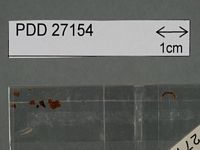|
 Tubaria hispidula Tubaria hispidula
SynonymsPhaeomarasmius hispidulus
BiostatusPresent in region - Indigenous. Endemic
Images (click to enlarge) | 
Caption: Dried type specimen
Owner: Herb PDD |
Article: Horak, E. (1980). Fungi Agaricini Novazelandiae. VIII. Phaeomarasmius Scherffel and Flammulaster Earle. New Zealand Journal of Botany 18(2): 173–182 (http://www.rsnz.org/publish/abstracts.php).
Description: Pileus -8 mm, hemispheric to convex, plane in over mature specimens; yellow-brown to brown with distinct rust-brown tinge; densely covered with appressed to spiny fibrillose minute squamules or scales, felty to velutinous towards margin; dry, not hygrophanous, margin not striate, veil remnants absent. Lamellae (L 8-10, -3) moderately crowded, subventricose; adnexed to adnate; pale reddish brown, becoming cinnamon-brown to rust-brown, edge albofimbriate. Stipe -10 x -I mm, cylindric, equal, central; concolorous with pileus; covered with hairy to lanose longitudinal fibrils, cortina forming distinct fibrillose girdle when young, evanescent with age; dry, hollow, single in groups. Context pale brown. Odour and taste not distinctive. Spores 5-6 x 4.5-5.5 µm, ovoid to subglobose, brown, smooth, membrane thin-walled, germ pore absent. Basidia 20-30 x 6-7 µm, 4-spored. Cheilocystidia 30-60 x 3-7 µm, cylindric or subfusoid with distinct capitate apex, sublecythiform, membrane thin-walled, hyaline, clamped at basal septum. Pleurocystidia and caulocystidia absent. Cuticle a trichoderm of cylindric hyphae, terminal cells not cystidioid, membrane not gelatinised, heavily encrusted with brown (KOH) pigment. Clamp connections numerous.
Habitat: on rotting leaves and stems of Olearia and Senecio (Compositae). New Zealand,
Notes: This species grows on well rotten debris of tree-daisies (Olearia) and groundsels (Senecio) in damp habitats. It is distinguished from all other New Zealand representatives of Phaeomarasmius by the following characters: small size of the carpophores, subglobose to ovoid spores, and slender subcapitate cheilocystidia. Compare also P. lanatulus Horak.
|